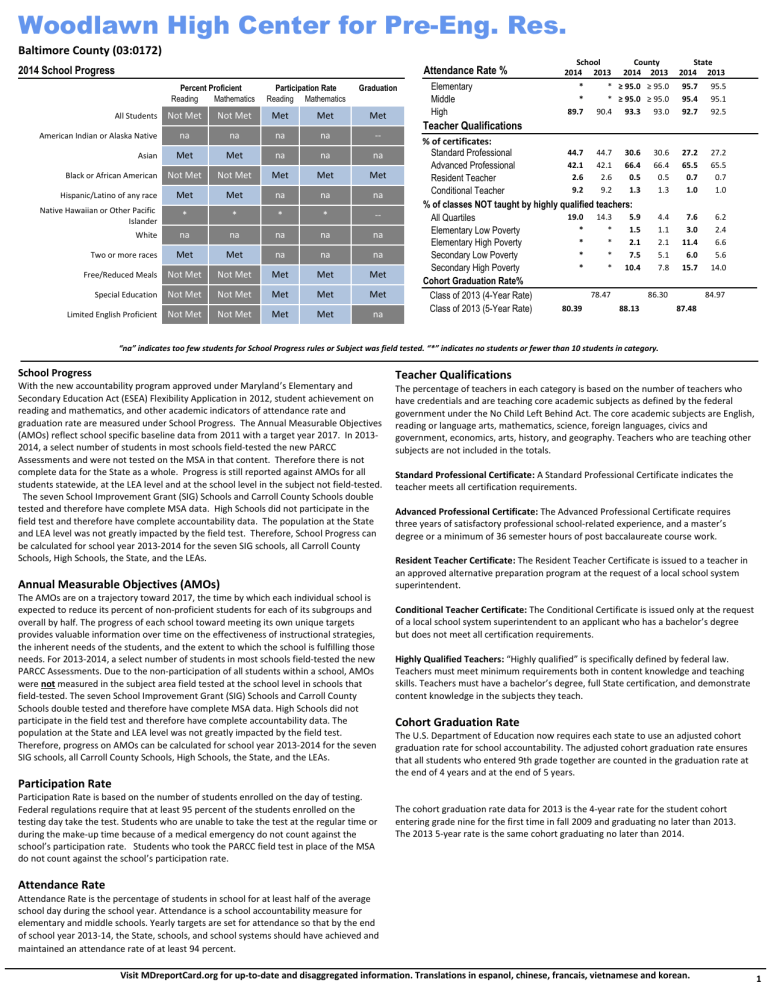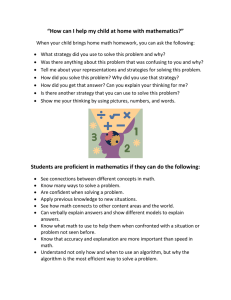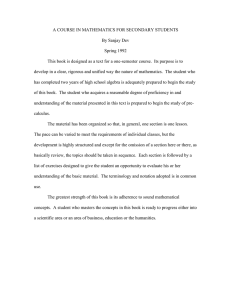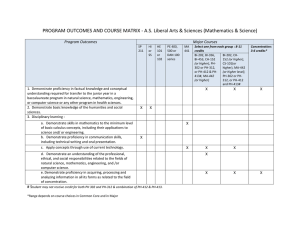Woodlawn High Center for Pre-Eng. Res.

Woodlawn High Center for Pre-Eng. Res.
Baltimore County (03:0172)
2014 School Progress
All Students
American Indian or Alaska Native
Asian
Black or African American
Hispanic/Latino of any race
Native Hawaiian or Other Pacific
Islander
White
Two or more races
Free/Reduced Meals
Special Education
Limited English Proficient
Percent Proficient
Reading Mathematics
Participation Rate
Reading Mathematics
Not Met Not Met na
Met na
Met
Not Met Not Met
Met
* na
Met
Met
* na
Met
Not Met Not Met
Not Met Not Met
Not Met Not Met
Met na na
Met na
* na na
Met
Met
Met
Met na na
Met na
* na na
Met
Met
Met
Graduation
Met
-na
Met na
-na na
Met
Met na
Attendance Rate %
Elementary
Middle
High
Teacher Qualifications
School
2014 2013
County
2014 2013
State
2014 2013
*
*
*
* шϵϱ͘Ϭ шϵϱ͘Ϭ шϵϱ͘Ϭ шϵϱ͘Ϭ
95.7
95.4
95.5
95.1
89.7
90.4
93.3
93.0
92.7
92.5
% of certificates:
Standard Professional
Advanced Professional
Resident Teacher
Conditional Teacher
Class of 2013 (5-Year Rate)
44.7
44.7
30.6
30.6
27.2
27.2
42.1
42.1
66.4
66.4
65.5
65.5
2.6
9.2
2.6
9.2
0.5
1.3
0.5
1.3
0.7
1.0
0.7
1.0
% of classes NOT taught by highly qualified teachers:
All Quartiles
Elementary Low Poverty
Elementary High Poverty
Secondary Low Poverty
Secondary High Poverty
19.0
14.3
* *
*
*
*
*
*
*
5.9
1.5
2.1
7.5
10.4
Cohort Graduation Rate%
Class of 2013 (4-Year Rate) 78.47
80.39
88.13
4.4
1.1
7.6
3.0
2.1
11.4
5.1
6.0
6.2
2.4
6.6
5.6
7.8
15.7
14.0
86.30
87.48
84.97
͞na͟indicates too few students for School Progress rules or Subject was field tested. ͞Ύ͟indicates no students or fewer than 10 students in category.
School Progress
With the new accountability program approved under Maryland͛s Elementary and
Secondary Education Act (ESEA) Flexibility Application in 2012, student achievement on reading and mathematics, and other academic indicators of attendance rate and graduation rate are measured under School Progress. The Annual Measurable Objectives
(AMOs) reflect school specific baseline data from 2011 with a target year 2017. In 2013-
2014, a select number of students in most schools field-tested the new PARCC
Assessments and were not tested on the MSA in that content. Therefore there is not complete data for the State as a whole. Progress is still reported against AMOs for all students statewide, at the LEA level and at the school level in the subject not field-tested.
The seven School Improvement Grant (SIG) Schools and Carroll County Schools double tested and therefore have complete MSA data. High Schools did not participate in the field test and therefore have complete accountability data. The population at the State and LEA level was not greatly impacted by the field test. Therefore, School Progress can be calculated for school year 2013-2014 for the seven SIG schools, all Carroll County
Schools, High Schools, the State, and the LEAs.
Teacher Qualifications
The percentage of teachers in each category is based on the number of teachers who have credentials and are teaching core academic subjects as defined by the federal government under the No Child Left Behind Act. The core academic subjects are English, reading or language arts, mathematics, science, foreign languages, civics and government, economics, arts, history, and geography. Teachers who are teaching other subjects are not included in the totals.
Standard Professional Certificate: A Standard Professional Certificate indicates the teacher meets all certification requirements.
Advanced Professional Certificate: The Advanced Professional Certificate requires three years of satisfactory professional school-related experience, and a master͛s degree or a minimum of 36 semester hours of post baccalaureate course work.
Resident Teacher Certificate: The Resident Teacher Certificate is issued to a teacher in an approved alternative preparation program at the request of a local school system superintendent.
Annual Measurable Objectives (AMOs)
The AMOs are on a trajectory toward 2017, the time by which each individual school is expected to reduce its percent of non-proficient students for each of its subgroups and overall by half. The progress of each school toward meeting its own unique targets provides valuable information over time on the effectiveness of instructional strategies, the inherent needs of the students, and the extent to which the school is fulfilling those needs. For 2013-2014, a select number of students in most schools field-tested the new
PARCC Assessments. Due to the non-participation of all students within a school, AMOs were not measured in the subject area field tested at the school level in schools that field-tested. The seven School Improvement Grant (SIG) Schools and Carroll County
Schools double tested and therefore have complete MSA data. High Schools did not participate in the field test and therefore have complete accountability data. The population at the State and LEA level was not greatly impacted by the field test.
Therefore, progress on AMOs can be calculated for school year 2013-2014 for the seven
SIG schools, all Carroll County Schools, High Schools, the State, and the LEAs.
Conditional Teacher Certificate: The Conditional Certificate is issued only at the request of a local school system superintendent to an applicant who has a bachelor͛s degree but does not meet all certification requirements.
Highly Qualified Teachers: ͞Highly qualified͟is specifically defined by federal law.
Teachers must meet minimum requirements both in content knowledge and teaching skills. Teachers must have a bachelor͛s degree, full State certification, and demonstrate content knowledge in the subjects they teach.
Cohort Graduation Rate
The U.S. Department of Education now requires each state to use an adjusted cohort graduation rate for school accountability. The adjusted cohort graduation rate ensures that all students who entered 9th grade together are counted in the graduation rate at the end of 4 years and at the end of 5 years.
Participation Rate
Participation Rate is based on the number of students enrolled on the day of testing.
Federal regulations require that at least 95 percent of the students enrolled on the testing day take the test. Students who are unable to take the test at the regular time or during the make-up time because of a medical emergency do not count against the school͛s participation rate. Students who took the PARCC field test in place of the MSA do not count against the school͛s participation rate.
The cohort graduation rate data for 2013 is the 4-year rate for the student cohort entering grade nine for the first time in fall 2009 and graduating no later than 2013.
The 2013 5-year rate is the same cohort graduating no later than 2014.
Attendance Rate
Attendance Rate is the percentage of students in school for at least half of the average school day during the school year. Attendance is a school accountability measure for elementary and middle schools. Yearly targets are set for attendance so that by the end of school year 2013-14, the State, schools, and school systems should have achieved and maintained an attendance rate of at least 94 percent.
Visit MDreportCard.org for up-to-date and disaggregated information. Translations in espanol, chinese, francais, vietnamese and korean.
1
Woodlawn High Center for Pre-Eng. Res
MSA Proficiency Levels
Basic % Proficient % Advanced %
Grade SCHOOL% COUNTY %
3 2014
6 2014
2013
7 2014
2013
8 2014
2013
*A 2014
2013
3 2014
2013
4 2014
2013
5 2014
2013
2013
5 2014
2013
8 2014
2013
*B 2014
2013
2013
4 2014
2013
5 2014
2013
6 2014
2013
7 2014
2013
8 2014
2013
*E 2014
Approximately 99% of Maryland students take MSA, 1% take Alt-MSA.
The Basic Level is below the goal set for all students.
STATE %
͞na͟indicates too few students for School Progress rules or Subject was field tested. ͞Ύ͟indicates no students or fewer than 10 students in category. ͻE: English; ͻA: Algebra/Data Analysis; ͻB: Biology
Description of MSA Proficiency Levels
Reading :
Students are unable to read and understand literature and passages of information that are written for students in their grade.
English :
Students have difficulty comprehending grade appropriate literature and applying language choices when writing.
Mathematics :
Students show they have only partially mastered the skills and concepts that Maryland expects students to know and be able to do at this grade level.
Algebra/Data Analysis :
Students show they have only partially mastered the skills and concepts defined in the Maryland Algebra/Data
Analysis Core Learning Goals.
Science :
Biology :
Students show they need more work Students demonstrate a minimal understanding of biology to attain proficiency. They use concepts, principles, and/or skills. Student responses indicate minimal supporting evidence, and responses provide little or no limited synthesis of information and understanding of scientific terminology.
synthesis of information.
Students can read text written for students in their grade, and they can demonstrate the ability to understand literature and passages of information.
Students can comprehend grade appropriate literature and apply appropriate language choices when writing.
Students show they have an understanding of fundamental
Students show they have an understanding of fundamental algebra grade level skills and concepts and / data analysis skills and concepts and can generally solve entry-level problems in mathematics.
can generally solve entry-level problems in algebra/data analysis.
Students use supporting evidence that is generally complete with some integration of scientific concepts, principles, and/or skills.
Students demonstrate a realistic and rigorous level of achievement by providing evidence of an understanding of biology concepts and the ability to use scientific evidence to generally integrate scientific concepts, principles, and/or skills.
Student responses indicate some synthesis of information and understanding of scientific terminology.
Students can regularly read text that is above their grade level, and they can demonstrate the ability to understand complex literature and passages of information.
Students can regularly comprehend and interpret complex literature and consistently apply
Students show they can regularly solve complex problems in mathematics and demonstrate superior ability to reason appropriate language choices to write effectively.
mathematically.
Students can regularly solve complex algebra/data analysis problems and demonstrate superior ability to reason mathematically.
Students use scientific evidence to demonstrate a full integration of
Students demonstrate an exemplary level of achievement by providing evidence of a complete understanding of biology scientific concepts, principles, and/or concepts and the ability to use scientific evidence to fully skills.
integrate scientific concepts, principles, and/or skills. Student responses indicate a complete synthesis of information and understanding of scientific terminology.
2
Visit MDreportCard.org for up-to-date and disaggregated information. Translations in espanol, chinese, francais, vietnamese and korean.
Woodlawn High Center for Pre-Eng. Re
Alt-MSA Proficiency Levels
Basic % Proficient % Advanced %
SCHOOL% COUNTY %
Grade
3 2014
2013
10 2014
2013
5 2014
2013
8 2014
2013
10 2014
2013
5 2014
2013
6 2014
2013
7 2014
2013
8 2014
2013
10 2014
2013
3 2014
2013
4 2014
2013
2013
4 2014
2013
5 2014
2013
6 2014
2013
7 2014
2013
8 2014
Approximately 1% of Maryland students take Alt-MSA. The Basic Level is below the goal set for all students.
STATE %
Maryland School Assessment (MSA)
The MSA measures what students in grades 3-8 know about reading and mathematics. High school performance is measured by the English and
Algebra/Data Analysis High School Assessment (HSA). Science was measured in grades 5 and 8 and by the Biology HSA starting in 2012. Science is not part of
School Progress. Performance is reported as the percent of students in each grade who achieved the Basic, Proficient, or Advanced standard. All students should be achieving at the Proficient or Advanced standard. High school special education students working on grade level content who may need an assessment that is more accessible for a student with disabilities may be eligible to take the Mod-
HSA. This is determined by the Individualized Education Program (IEP) Team.
Alternate Maryland School Assessment (Alt-
MSA)
The Alternate Maryland School Assessment (Alt-MSA) is taken by students with disabilities who cannot take the MSA even with the special accommodations they receive as part of their regular classroom instruction.
The test measures the student͛s mastery of reading and mathematics content standards or appropriate access skills. Eligible students take the test in grades
3-8 and once during the high school grade band. Performance is reported as the percent of students in each grade who achieved the Basic, Proficient, or
Advanced standard.
Visit MDreportCard.org for up-to-date and disaggregated information. Translations in espanol, chinese, francais, vietnamese and korean.
3
Woodlawn High Center for Pre-Eng. R
2014 School Progress Index (SPI)
ACHIEVEMENT GAP REDUCTION
2014 SPI: 0.8905
Values 1.0000 and above met the target.
COLLEGE & CAREER READINESS
Algebra
0.8982
English
0.8186
Biology
0.8777
Algebra English Biology Grad.
Ώ Dropout Ώ
0.6141
1.0156
0.6071
1.0307
1.1012
Graduation
1.0535
Ώ
CCP ΐ
0.8581
School Progress Index (SPI)
The new Maryland School Progress Index is based on high expectations and multiple measures that include student achievement data in Reading, Mathematics, and Science; growth data in English/Language Arts and Mathematics; and gaps, based on the gap score between the highest-achieving and lowest achieving subgroup in mathematics, reading, science, cohort graduation and cohort dropout rates. Maryland͛s School Progress Index will differentiate schools into one of five strands which determine the system and State support schools receive. The State affords top-performing schools greater flexibility while lower performing schools receive progressively more prescriptive technical assistance, expectations, and monitoring.
The School Progress Index evaluates schools on a continuous scale based on the variables of Achievement, Growth,
Gap Reduction, and College- and Career-Readiness. The Indicators are specific to Elementary and Middle Schools or
High Schools. Each Indicator is comprised of specific Measures for Elementary and Middle schools or High Schools. An index score of 1.0 is indicative of meeting all the targets, whereas a score greater than 1.0 means the school surpassed its targets.
Achievement: Achievement represents the acquisition of the skills and knowledge students have acquired. The
Achievement Indicator represents the school͛s performance for ͞all students͟on the MSA, Alt-MSA, and Mod-HSA in meeting Mathematics, Reading, and Science proficient and advanced levels relative to the school͛s targets.
Achievement is measured in all grades.
Growth:
Growth represents a student͛s progress from one year to the next. The Growth Indicator represents all students͛growth within an elementary or middle school in attaining Mathematics Proficiency and Reading Proficiency.
Gap Reduction: Gap Reduction represents a decrease in the difference between the highest-achieving subgroup and the lowest achieving subgroup by content areas. The Gap Indicator represents the differences between the highest and lowest performing subgroups in Mathematics Proficiency, English/Language Arts Proficiency, and Science
Proficiency at all grade levels and the five-year adjusted cohort graduation rate and four-year adjusted cohort dropout rate for high schools.
College- and Career-Readiness (CCR):
College- and Career-Readiness represents a combination of measures that ensure students are college and career ready upon graduation. Measured in high schools, CCR consists of the 5-year adjusted cohort graduation rate and
College and Career Preparation (CCP). CCP is a measurement of a student who has exited high school with a
Maryland State High School Diploma and met success in one of the following areas: Earning a 3 or better on an
Advanced Placement (AP) Exam or a 4 or better on an International Baccalaureate Exam; Attaining advanced standing in a Career and Technology Education (CTE) Program of study; or Enrolled in a post-secondary nstitution (2year, 4-year, or technical) within 16 months of graduation.
Strands for Intervention, Support, and Recognition
The School Progress Index (SPI) and the school͛s result on each of the Indicators of the Index will give the school a very clear picture of its progress toward meeting targets. Once the School Progress Index is calculated (with values of
0 to 1 or greater), the scores will be broken into five strands for identifying interventions, support, and recognition to schools (Not applicable for LEAs). Schools in Strand 1 will be schools meeting all targets and schools not meeting any of their targets will be in Strand 5. Although schools will, as always, have very unique profiles, the Maryland State
Department of Education (MSDE) will group the schools based on a measure of the magnitude of the issues these schools face when meeting their targets. This Strand categorization allows MSDE and the Local Education Agency
(LEA) to differentiate resources to schools by magnitude of need while precise diagnosis occurs at the school.
Please note , for school year 2013-2014, SPI was only calculated for the State, LEA, High Schools and Schools that double tested (took the MSA and the PARCC field test). The seven School Improvement Grant (SIG) Schools and
Carroll County Schools double tested and therefore have complete MSA data. High Schools did not participate in the field test and therefore have complete accountability data. The population at the State and LEA level was not greatly impacted by the field test. Therefore, SPI can be calculated for school year 2013-2014 for the seven SIG schools, all
Carroll County Schools, High Schools, the State, and the LEAs.
ΏCollege and Career Preparation (CCP) ʹϮϬϭϮ ΐData from 2013
4
Visit MDreportCard.org for up-to-date and disaggregated information. Translations in espanol, chinese, francais, vietnamese and korean.


